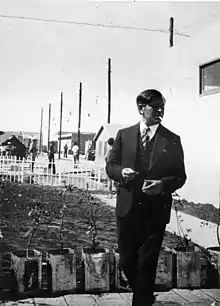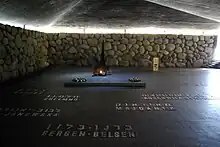Arieh El-Hanani
Arieh El-Hanani, born Sapozhnikov[1][2][3] (1898–1985) was an Israel Prize winner in the field of architecture for his "contribution to shaping Israeli culture."
His Russian and Hebrew names have also been transliterated and spelled as Arie or Aryeh, Sapoznikov, Elhanani, etc.

Early life in Russia
El-Hanani was born in 1898 in Poltava, Russian Empire (today capital of the Poltava Oblast in central Ukraine), to as one of the five children of Elhanan (Afanasi) Sapozhnikov and Chava Liva Sapozhnikov(a).[4][5] His siblings were Mania Sapozhnikov, Zvi (Grisha) Elhanani, Avraham Elhanani, and Meir (Misha) Elhanani.[4]
Education
Between 1913 and 1917, Elhanani completed a course in architecture at the Kiev School of Art and Architecture.[6]
Avant-garde artist
In 1917 he joined a group of artists from Kharkov with whom he designed revolutionary propaganda posters.[1] El-Hanani participated in the anthropological Jewish expedition under the leadership of S. Ansky into the Pale of Settlement, which exerted a substantial influence on Russian-Jewish avant-garde art.[1]
Mandate Palestine and Israel
In 1922 El-Hanani immigrated to Mandate Palestine,[1][6] where he settled in Jerusalem.[7]
Stage design
In the 1920s and 1930s Elhanani continued his avant-garde work by designing sets and costumes for theatre plays such as "Nishfei Peretz" (lit. 'Peretz soireés'; 1926) and "Megilat Esther" (lit. 'Book of Esther'; 1930).[5] He designed the set for the first production of the ohel (lit. 'tent') workers' theatre, dedicated to the stories of Isaac Leib Peretz, and was one of the designers for the second ohel exhibition of 1927.[1]
Trade fair design

El-Hanani found work as a trade fair designer.[6] In 1934 he both designed and managed the site of the Levant Fair in Tel Aviv. This rendered him responsible for some of the buildings and sculptures at the fair, most specifically the Fair's symbol, the Flying Camel.[5][6] Also for the Fair he created an 8-meter high sculpture in the style of Russian Constructivism, known as "The Hebrew Laborer",[7] erected in 1934 and restored in 1989 when the original material, iron, was replaced by concrete and steel.[8] Eventually he designed pavilions for trade fairs abroad.[6] El-Hanani also planned the Tel Aviv Convention Center.
Architecture


El-Hanani designed a number of buildings, some of which have become iconic in Israel.
For Yad Vashem, the national Holocaust memorial, El-Hanani designed the Hall of Remembrance (1957-1961) working alongside Arieh Sharon and Benjamin Idelson, and participated as a judge in the design competition for the Valley of the Destroyed Communities.[9][10][5]
He designed the municipal auditorium in Kfar Saba, the Gan Ha'ir Tower of Tel Aviv, and several buildings of the Weizmann Institute of Science, of which the Wix Library (1957) constitutes one of the works he's best known for.[5] His other Weizmann Institute projects are the Jacob Ziskind Building (together with Israel Dicker and Uriel Schiller, 1947, according to a sketch by Erich Mendelsohn),[11] the Isaac Wolfson Building (1953), the Modernist-Brutalist Conference Center (1958),[11] the Charles Clore International House (with Nissan Canaan, 1963),[11][12] and the Stone Administration Building (with Nissan Canaan, 1966).[11]
After the first Weizmann Institute projects, El-Hanani went on to design other buildings for institutes of higher learning, such as the Wurzweiler Central Library of the Bar-Ilan University (with Nissan Canaan, 1967).[6][13][14]
Other design work
Apart from stage design, Elhanani also worked in the fields of graphic design, sculpture, and typography.[15]
The Russian avant-garde style can be easily recognised in his work for the Hebrew-language monthly youth magazine "Moledeth" ("Homeland") published in the 1920s in Erez Israel.[16]
El-Hanani designed the logos of the pre-state Palmach paramilitary, and later that of the Israel Defense Forces.[5]
Awards - both received and created in his name
- The Israel Prize for Architecture, awarded to El-Hanani in 1973[6]
- The Elhanani Prize for Integration of Art and Architecture, named for him and awarded by his family and the Yehoshua Rabinowitz Fund[5]
Personal life
Arieh Elhanani was married to Sara with whom he had two children including a daughter, Michal (later Michal Golan).[4]
External links
- 16 posters by Arieh El-Hanani (Sapozhnikov), mainly 1920s-30s, at The Palestine Poster Project Archives. Retrieved 3 November 2020.
References
- Manor, Dalia (2004). Art in Zion: The Genesis of Modern National Art in Jewish Palestine. Routledge Jewish Studies Series. Routledge. p. 234 fn. 75. ISBN 9781134367825. Retrieved 4 May 2015.
- Arie El Hanani, Israel Museum website. Retrieved 3 November 2020.
- Arieh El-Hanani (Sapozhnikov), The Palestine Poster Project Archives website, spin-off of Master's degree thesis by Dan Walsh, Georgetown University. Retrieved 3 November 2020.
- "Arieh (Lola) Elhanani public profile". Geni. Retrieved 4 May 2015.
- "Information Center for Israeli Art". Israel Museum. Retrieved 3 November 2015.
- "Elhanani, Aryeh". Encyclopaedia Judaica. Retrieved 3 November 2020.
- "The Architects". Weizmann Institute of Science. Archived from the original on 27 August 2014. Retrieved 4 May 2015.
- Sign: Tel Aviv - "The Hebrew Laborer" - Outdoor sculpture by Arieh El-Hanani, streetSigns.co.il. Retrieved 3 November 2020.
- Neuman, Eran (2014). Monumental Holocaust Landscapes at Yad Vashem. p. 86. ISBN 9781472435996. Retrieved 4 May 2015.
{{cite book}}:|work=ignored (help) - The Hall of Remembrance, Yad Vashem official website. Retrieved 3 November 2020.
- Campus Buildings (PDF). Rehovot: Weizmann Institute of Science. 2009. pp. 14, 16, 24, 28, 72, 74. Retrieved 3 November 2020.
- "Weizmann Institute of Science". The Charles Clore Residence. Potash. Archived from the original on 25 November 2015. Retrieved 4 May 2015.
- "Wurzweiler Central Library". #SOSBRUTALISM. German Architecture Museum (DAM), Frankfurt and the Wüstenrot Foundation, Ludwigsburg. Retrieved 4 November 2020.
- Historical Milestones, Bar-Ilan University. Retrieved 4 May 2015.
- "Ohel Yizkor; 1957; Elhanani, Arieh". Art, Architecture and Engineering Library. Retrieved 4 May 2015.
- Moledeth ("Homeland") monthly, c. 1926, front cover: illustration and design by Sapozhnikov (El-Hanani). eBay, with illustrations. Retrieved 3 November 2020.